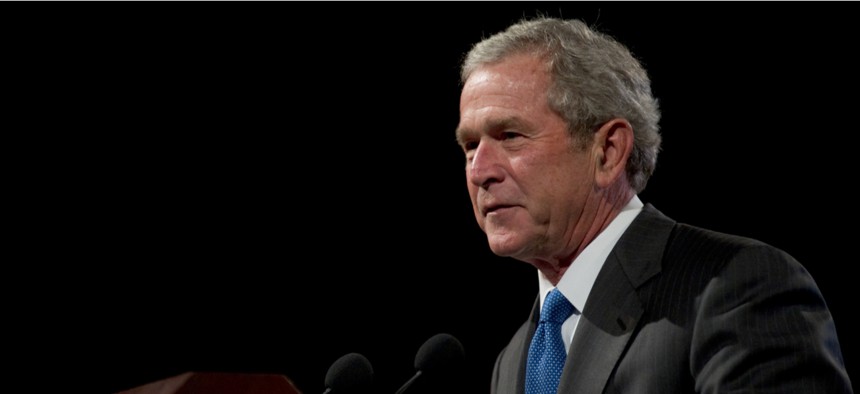A Quiet Legacy: The Bush Management Agenda Continues to Impact Government
Reform is inherently nonpartisan, and it’s important to keep moving the goal post.
Alumni from the George W. Bush administration recently gathered in Washington to mark the 10-year anniversary of President’s Bush’s departure from office and reminisce about his administration’s accomplishments. For those of us who served the president in that era, particularly in government management, we reflected on how much of what we were working on then laid the foundation for the efforts of today.
When a new administration is sworn in, it’s often a chance to reset a policy agenda to reflect the vision the new president laid out during the campaign. However, because government management reform is inherently non-partisan and advancements are achieved over a longer time frame, the initiatives from a previous administration are worth keeping in place. Thus, it’s important to preserve and celebrate continuity across multiple administrations’ management agendas. But it is also important for an administration to leave its mark and raise the government’s game so that future administrations are playing to a new goal post.
The Bush management agenda did just that, creating a framework with such clear performance measures, transparency and individual accountability that it stunned some government leaders at the time who were used to a much murkier environment by which their success or failure would be evaluated. The Bush management agenda was marked by quarterly, publicly released scores (red, yellow, or green) to denote agency progress toward addressing important management challenges. In one dramatic incident, which demonstrates just how seriously these scores were taken, a policy official threatened to do bodily harm to a surprised Office of Management and Budget examiner if a red grade on human capital management was not immediately changed to green.
Getting consensus on an approach to management improvement is essential. Collaboration is key. The red, yellow, green scorecard was developed early in the Bush administration in close collaboration with OMB and the President’s Management Council, a group designated during the Clinton administration to drive management improvement across agencies. The Bush administration sustained the council because it was a good idea and deserved to continue. And it proved critical in the development and oversight of the management agenda.
The scorecard attempted to drive improvements in performance, financial management, information technology, acquisition, and human capital. Because it was designed around the government’s greatest management challenges as defined by the Government Accountability Office , most agencies rated reds for most areas. Many weren’t happy, but each quarter, grades continued to be released publicly and progress was scrutinized by many inside and outside government, including President Bush. Public attention to those grades drove agency leaders to work on improvements. By the end of the Bush administration, most had made systematic improvements to their operations.
That progress has been sustained as successive administrations remained focused on solving the same challenges—reducing improper payments, migrating to shared services, improving management of real property and strengthening human capital.
Agencies have greater insight into the root causes of improper payments than ever before. The drive to migrate back-office functions to shared services centers is embodied in the cross agency performance goal, Sharing Quality Services, and the OMB memorandum, Centralized Mission Support Capabilities for the Federal Government. Because the government is the largest landowner in the world, real property management improvement efforts have continued unabated. Last year, agencies reduced their office and warehouse space by 3.87 million square feet and avoided costs of $66 million. And because the Bush administration first launched governmentwide employee engagement surveys, agencies are making targeted efforts to improve employee satisfaction and retention.
One of the major lasting improvements that emerged during the Bush presidency was in the area of government transparency. Not only were quarterly scorecards published electronically, but the 2006 Federal Funding Accountability and Transparency Act required agencies for the first time to post financial transactions monthly on USASpending.gov. The depth, accuracy, and analysis of this massive data source has improved steadily since it was first made available.
The U.S. government is the largest, most complex organization in the world, and it faces enormous challenges. Whether it’s reducing improper payments, consolidating shared services, recruiting and retaining talent, or doubling down on transparency, progress takes time. It’s refreshing to note, especially in such divisive times, that important management improvement initiatives have been sustained across successive administrations. Here’s hoping that continues.
Robert Shea, a former senior official at the U.S. Office of Management and Budget, is a Principal with Grant Thornton Public Sector. Danny Werfel, former Federal Controller and Acting Commissioner of the Internal Revenue Service, is a Managing Director and Partner at The Boston Consulting Group.
Image via Christopher Halloran/Shutterstock.com.
NEXT STORY: How Employees Pollute Their Own Office Space



